
still need the previous edition?
![]() .Events .Moon .Planets .Minor Planets, NEOs .Comets .Shooting Stars .Occultations .Sun .check more! (occultations observers are advised to check in 'Events', and to turn to such dedicated sites like the I.O.T.A). don't forget to check the weather! For the US: the NOAA . color codes: Wwd worldwide, UsA USA-Americas, EuA Europe-Africa, AsP Asia-Pacific, Chk Check for Your Zone. check the site's concept and the instructions of use
.Events .Moon .Planets .Minor Planets, NEOs .Comets .Shooting Stars .Occultations .Sun .check more! (occultations observers are advised to check in 'Events', and to turn to such dedicated sites like the I.O.T.A). don't forget to check the weather! For the US: the NOAA . color codes: Wwd worldwide, UsA USA-Americas, EuA Europe-Africa, AsP Asia-Pacific, Chk Check for Your Zone. check the site's concept and the instructions of use
![]()
![]() Editor's Choice Fine Picture Archives
Editor's Choice Fine Picture Archives ![]() Editor's Choice Sky At
Editor's Choice Sky At ![]()
![]()
![]() Tech News
Tech News ![]() color codes: Wwd worldwide, UsA USA-Americas, EuA Europe-Africa, AsP Asia-Pacific, Chk Check for Your Zone. check the site's concept and the instructions of use
color codes: Wwd worldwide, UsA USA-Americas, EuA Europe-Africa, AsP Asia-Pacific, Chk Check for Your Zone. check the site's concept and the instructions of use
| Tweet |
.Events Seen All Month Long .Ephemerides Proper
(data from the former yearly ephemerides generator at Fred Espenak's NASA's eclipse website; miscellaneous data with the 'Astronomical Phenomena for The Year 2020,' a joint work by the United Kingdom Hydrographic Office and the U.S. Naval Observatory; to be found at the latter's site; all time UT except otherwise stated)
Wwd Saturn, Jupiter and Mars -- and even Pluto -- are clustered fine morning stars in the northern hemisphere! The show is high, by 45 degree of altitude at the Tropics or higher further in the southern hemisphere. The show is the tightest since mid-month as a serie of exceptional views occur until late March! Rare visual and photographic oppotunities as Moon will come to add, or Mercury is lower from the show for some locations! The cluster may be seen in the night preceding dawn when available
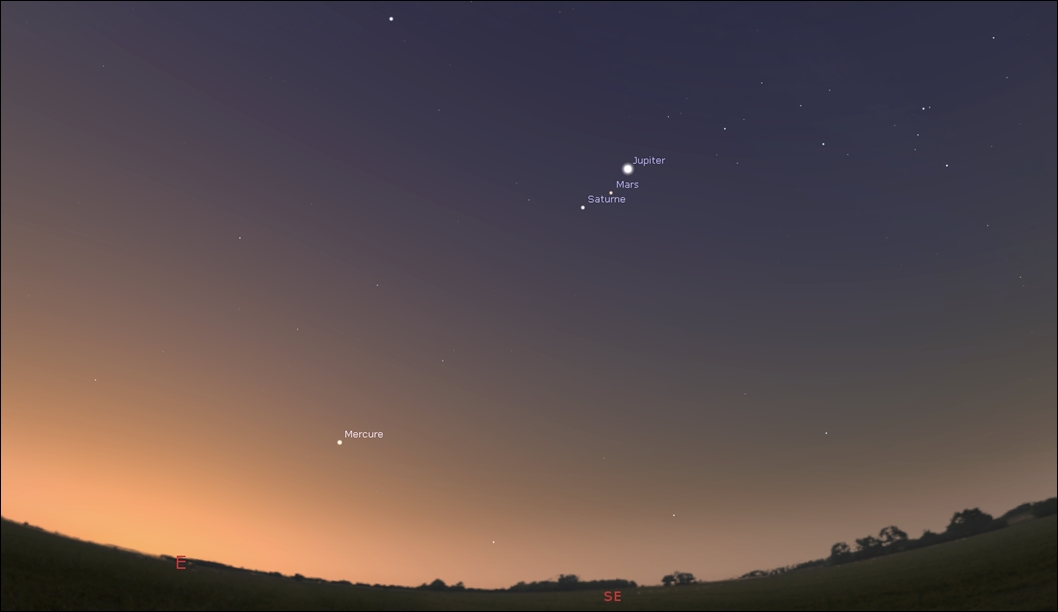 | Mars, Jupiter, Saturn, and even Pluto, remarkably clustering like morning stars! picture site 'Amateur Astronomy' based upon the Stellarium software |
Wwd At the Tropics or the southern hemisphere by dawn, fine bright stars are seen South!
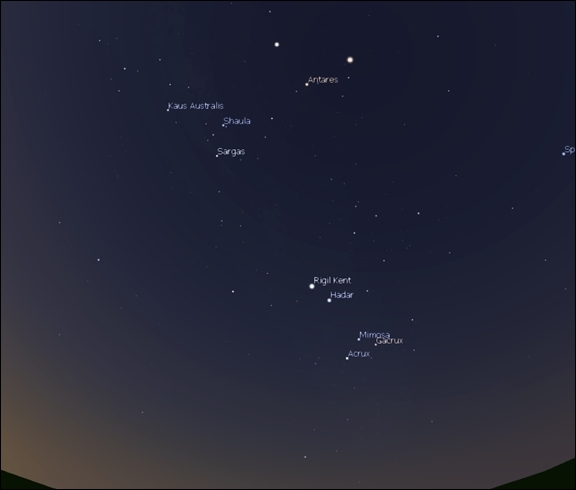 | Fine bright stars are seen South, by dawn in the southern hemisphere! picture site 'Amateur Astronomy' based upon Stellarium |
1 (1) UsA First quartered Moon, at all latitudes, is close to Aldebaran, the bright star to constellation Taurus, the Bull. The show may be seen as soon as by twilight
1 (2) Wwd There is a occultation of minor planet Vesta today by Moon! check more at Occultations; check more too at such sites like "The International Occultation Timing Association" (I.O.T.A.)
2 EuA AsP First Quarter, by all latitudes, is close to Aldebaran, the bright star to constellation Taurus, the Bull. The show may be seen as soon as by twilight
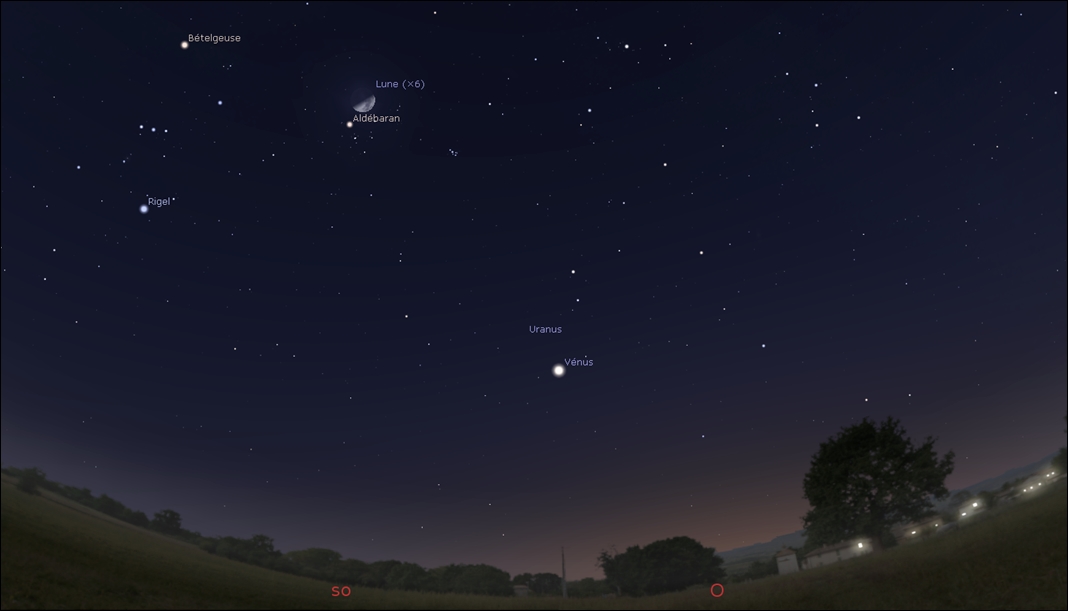 | Moon close to Aldebaran, the bright star to constellation Taurus, the Bull! picture site 'Amateur Astronomy' based upon the Stellarium software |
4 Wwd Moon is at a ascending node at 14:58 UT
5 (1) Wwd Waxing gibbous Moon, at all latitudes, is seen close to Pollux and Castor, main stars to constellation Gemini, the Twins, tonight!
5 (2) Wwd Moon reaches a northernmost declination at 01:34 UT
10 Wwd Moon is at its perigee at 06:33 UT (distances non available)
17 (1) Wwd Tomorrow morning by dawn, by all latitudes, last quartered Moon is seen close to the cluster of Mars-Jupiter-Saturn like morning stars. The show is also available next morning for the Europe-Africa and Asia-Pacific areas only!
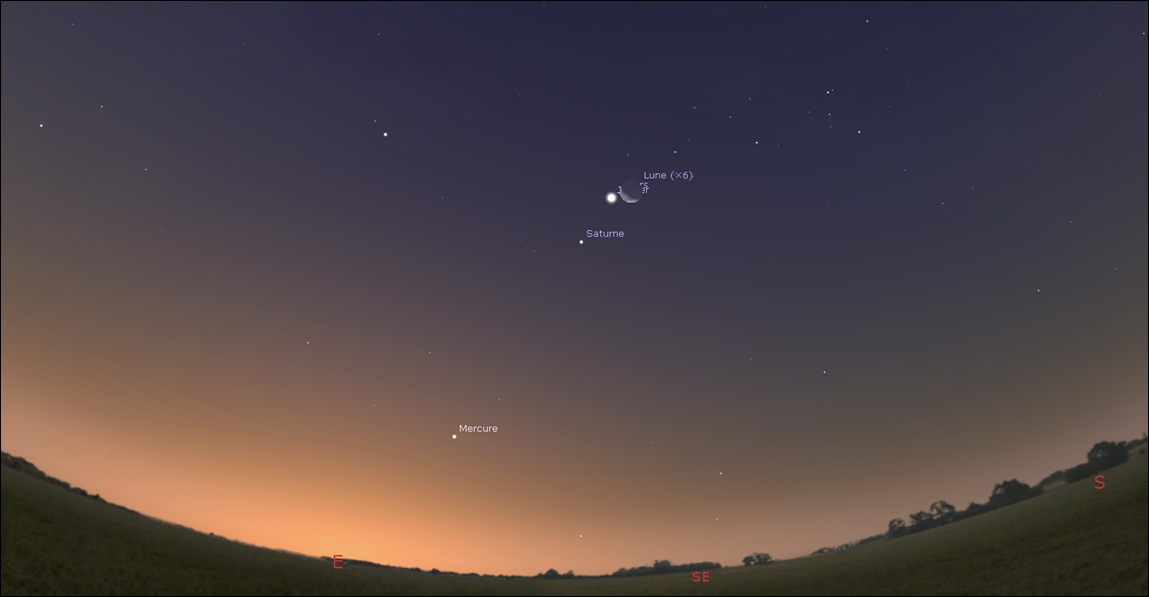 | Moon is close to the cluster of planets seen like morning stars! picture site 'Amateur Astronomy' based upon the Stellarium software |
17 (2) Wwd Moon is at a descending node at 01:00 UT, as it also reaches a southernmost declination at 14:07 UT
18 (1) Wwd There is a occultation of Mars today by Moon! check more at Occultations; check more too at such sites like "The International Occultation Timing Association" (I.O.T.A.)
18 (2) Wwd There is a occultation of Pluto today by Moon! check more at Occultations; check more too at such sites like "The International Occultation Timing Association" (I.O.T.A.)
20 (1) Wwd It is the spring, or vernal equinox today, by 03:50. Nighttime equal daytime worldwide! check more details about Earth's seasons with our tutorial Seasons
20 (2) UsA Tomorrow morning by dawn, at the Tropics and the southern hemisphere, last crescent is seen close to Mercury!
21 EuA AsP Tomorrow morning by dawn, at the Tropics and the southern hemisphere, very last crescent is seen close to Mercury!
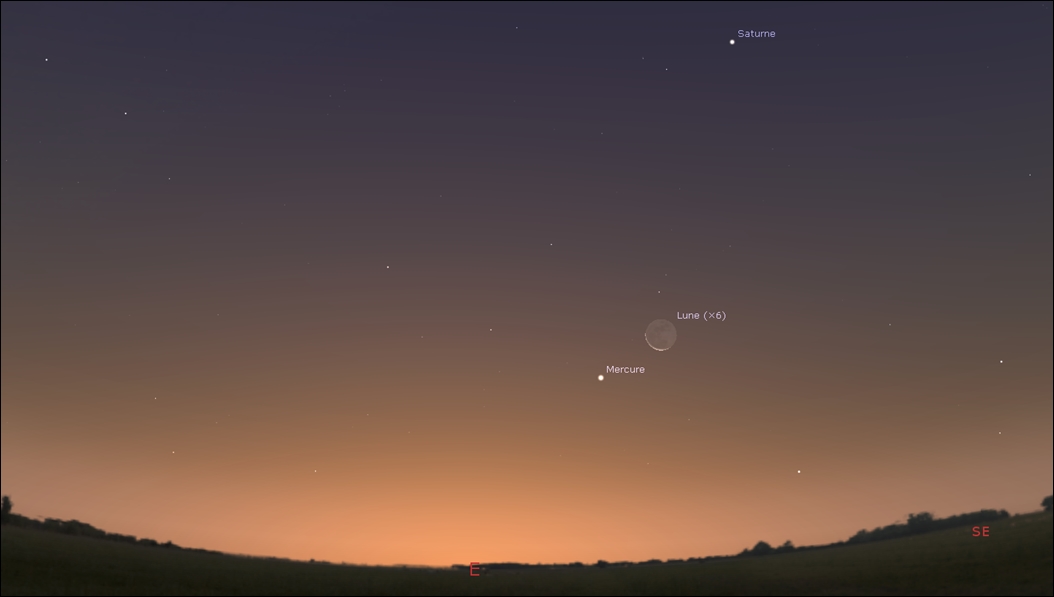 | Moon close to Mercury by dawn! picture site 'Amateur Astronomy' based upon the Stellarium software |
24 Wwd Moon is at its apogee at 15:23 UT (distances non available)
27 AsP First crescent, a fine show, at all latitudes, is seen close to Venus in the evening twilight! The show may last into the night when available
28 Wwd First crescent, by all latitudes, a fine show, is seen close to Venus in the evening twilight! The show may last into the night when available
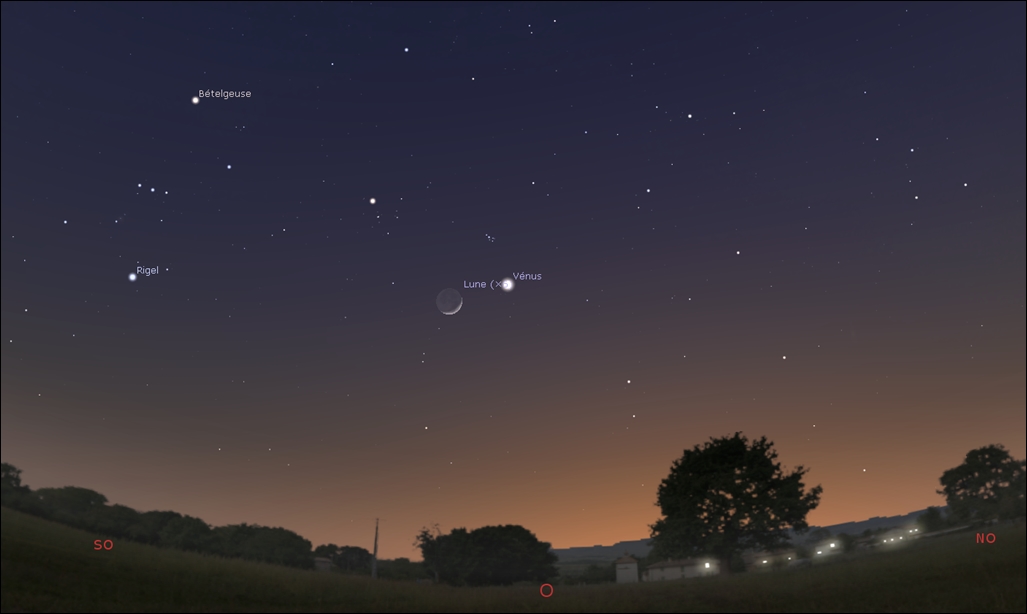 | Moon close to Venus by twilight! picture site 'Amateur Astronomy' based upon the Stellarium software |
29 (1) Wwd First Quarter, by all latitudes, is close to Aldebaran again, the bright star to constellation Taurus, the Bull. The show may be seen as soon as by twilight
29 (2) Wwd There is a occultation of minor planet Vesta today by Moon! check more at Occultations; check more too at such sites like "The International Occultation Timing Association" (I.O.T.A.)
31 Wwd Moon is at a ascending node at 16:51 UT
Occultations observers are advised to turn to such dedicated sites like the I.O.T.A as they may also check below at our Occultation section
First Quarter is on March 2nd, at 19:57 UT
Full Moon is on March 9th, at 17:48 UT
Last Quarter is on March 16th, at 09:34 UT
New Moon is on March 24th, at 09:28 UT
(source: Ephemeris generator at Fred Espenak's NASA's eclipse website)
for what a remarkable configuration of a planet is, check our tutorial 'Planets Apparent Motion'
Mercury is reaching a greatest western elongation on Mar. 24th by 01:59 UT. Mercury turns a remarkable morning star at the Tropics or the southern hemisphere, as March unfolds. The show is about null in the northern hemisphere
Venus is reaching a greatest eastern elongation on Mar. 24th 2020 by 22:00 UT. Venus is now at its best, a very high evening star. It is seen into the night in the northern hemisphere or the Tropics as it's low by that time in the southern hemisphere
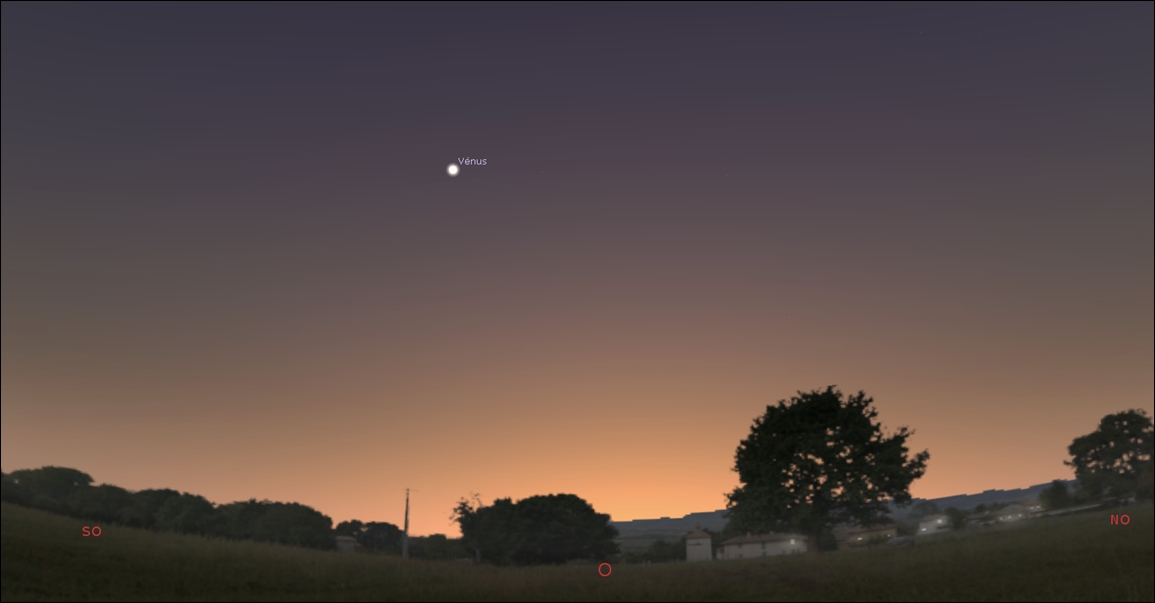 | Venus a fine evening star! picture site 'Amateur Astronomy' based upon the Stellarium software |
Mars Mars Observation Campaign! is now seeing the beginning of its Mars Observation Campaign 2020-2021! Mars now is a fine morning star in the northern hemisphere, finer still at the Tropics and very high in the southern hemisphere. A Mars observation campaign, the Mars Observation Campaign 2020-2021 is unfolding from March 19th, 2020 when Mars will reach 6" of apparent diameter, until March 10th, 2021 when Mars will be back to that value, a value afficionados deem the least observable. check more at our Mars Observation Campaign 2020-2021 page
 | The Mars Observation Campaign 2020-2021 is beginning in March! picture site 'Amateur Astronomy' based upon the Celestia software |
Jupiter now is a fine morning star in the northern hemisphere, finer still at the Tropics, and higher further in the southern hemisphere
Saturn is a fine morning star in the northern hemisphere, finer still at the Tropics and higher further in the southern hemisphere. Following a ring aperture maximum, rings now are closing
Uranus is bound to a conjunction next month. It's setting early in the northern hemisphere, the Tropics and earlier still in the southern hemisphere
Neptune is reaching its conjunction on Mar. 8th by 12:09 UT and unavailable wordlwide
Pluto albeit low before dawn in the northern hemisphere, begins to be back for observation. It's well back to, at the Tropics due to a late dawn, or in the southern hemisphere (according to the International Astronomical Union (IAU) since 2006, Pluto is not considered a planet anymore, but categorized like a dwarf planet instead along with Ceres, Eris, Makemake, and Haumea, and the prototype of a new category of 'trans-Neptunian', 'Pluto-class' objects)
Minor planets are those biggest asteroids in the Asteroid Belt which may be easily observed by amateurs from the Earth, namely Ceres, Pallas, Juno, and Vesta (due to the new categorization by the International Astronomical Union (IAU) by 2006, Ceres belongs to the 5 dwarf planets in the solar system with Pluto, Eris, Makemake, and Haumea). check data and charts at our section Minor Planets on the yearly Calendar page as our tutorial 'Asteroids and Asteroid Hunting' is of help too. Any remarkable event linked to a minor planet may have a notice here below
Some small asteroids dubbed Near-Earth Objects (NEOs) are regularly making close approaches at Earth. People interested in such close approaches may obtain recent and upcoming data at NASA (JPL) site Center for Near Earth Object Studies (CNEOS) (their section "Close Approaches"). Miscellaneous data are available. For further observational purposes, check at their ephemeris Generator (via Tools/Neo DB Query)
. For more about NEOs see tutorial "
Once every time, the solar system treats us with a remarkable comet, a eery view spanning up to thirty degrees of sky! Most of the time however comets are the domain of dedicated observers as mostly weak and, at the most, hovering at the limit of the naked-eye visibility. A good site to get information about current such comets is the British Astronomical Association Comet Section page or also the Weekly Information about Bright Comets page (which often points to comets close to the visual magnitude). Our 'Comets and Comet Hunting' tutorial will also be helpful. Remarkable comets otherwise usually will be presented below!
->note: shooting stars afficionados will be aware of checking Moon at the dates of the showers
for more about the meteor showers of this month, for possible other meteor showers for this month, and for more about shooting stars, generally, see our tutorial "Shooting Stars"
Each month, Moon occults some relatively bright stars, that is the Moon, beginning either with its bright or its dark visible face, is passing in front of a star. This is called an occultation. The Pleiades, on the other hand, due to their position near the eclipic, are often occulted by Moon too. Some planets, at last, along the year, may be occulted by Moon or they themselves, or their satellites, may be seen too occulting a star. The asteroids too may occult stars. Yearly lists of such phenomenons are to be found at Sky & Telescope/SkyTonight.com, either in their newsstand issues or at their site, as a list of occultations of most brilliant stars, the planets and the Pleiades are available at the I.O.T.A site (I.O.T.A. stands for "The International Occultation Timing Association"). Most notable occultations are signaled below. Are given here only planetary occultations; for bright stars occultations, check at such sites like "The International Occultation Timing Association" (I.O.T.A.)
Minor planet Vesta back is occulted by Moon on Mar. 1st, 2018 by 08:00 UT! The show is available for western and northernAustralia, eastern Indonesia,north western Melanesia,Micronesia, Hawaii. check more at such sites like "The International Occultation Timing Association" (I.O.T.A.)
Mars back is occulted by Moon on Mar. 18th, 2018 by 08:00 UT! The show is available for southernmost SouthAmerica, South Georgia,Antarctica, Kerguelen Islands. check more at such sites like "The International Occultation Timing Association" (I.O.T.A.)
Pluto back is occulted by Moon on Mar. 18th, 2018 by 08:00 UT! The show is available for most of Antarctica. check more at such sites like "The International Occultation Timing Association" (I.O.T.A.)
Minor planet Vesta back is occulted by Moon on Mar. 29th, 2018 by 08:00 UT! The show is available for southern Indian Ocean,Indonesia, parts of SouthEast Asia, Philippines,Micronesia, northernPolynesia (except Hawaii). check more at such sites like "The International Occultation Timing Association" (I.O.T.A.)
check on this site for more about occultations, theoretically
| CAUTION! OBSERVING THE SUN IS DANGEROUS AND REQUIRES DEDICATED SAFE TECHNIQUES! |